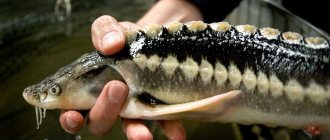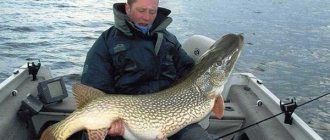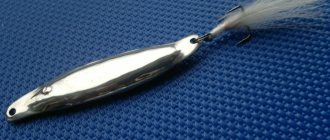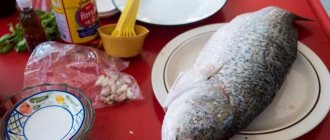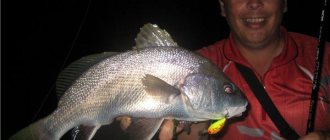A few years ago, Thursday in Russia was a fish day.
Nowadays, sea fish is on dinner tables almost every day. This can be easily explained by the variety of its types. We'll look at them below. Most often you
- Do it yourself 63%, 48 votes
48 votes 63%48 votes - 63% of all votes
- Buy ready-made sprats 26%, 20 votes
20 votes 26%
20 votes - 26% of all votes
- I don't eat fish 11%, 8 votes
8 votes 11%
8 votes - 11% of all votes
Total votes: 76
06.02.2020
×
You or from your IP have already voted.
Stickleback, 50 mm
The stickleback grows to a mere five centimeters. A distinctive feature of this species is the presence of special, sharp fins, which the fish, in case of danger, uses as protection from predators.
Another feature is that representatives of these fish live in fresh, salty and slightly salty waters. They love to eat, and where they swim, it becomes very difficult for other species to survive.
Sticklebacks are not considered as a commercial species due to their small size and small amount of meat in them. But this was not always the case, and this type of fish saved people from hunger. In memory of this event, there was even a monument to Kolyushka, which was erected in the city of Kronstadt.
The fish is found in the Black Sea, as well as in the Caspian and Azov seas. In fresh and slightly salty waters, fish are more comfortable being in a school, but in sea water they usually stay alone. When breeding offspring, sticklebacks build nests, and during spawning their stomachs become overgrown and begin to work only after spawning.
Bull shark
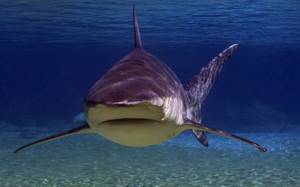
The fish of the seas and oceans are diverse; there are more than three hundred and fifty species of sharks alone, of which one of the most interesting is the bull shark. This creature is much smaller in size than Carcharodon, but is more adapted to existence. Thus, it is found not only in salty waters of seas and oceans, but also in fresh rivers and lakes. This species stays in coastal zones and rarely swims to a depth of more than a hundred meters, which is why it is the most dangerous for people.
The maximum recorded length of the bluntnose shark is four meters, and its weight is four hundred kilograms. It was this predator that became the “muse” for the creation of the legendary “Jaws”, as it is the leader in the number of attacks on humans.
The gray bull shark is very lazy and prefers to hunt in murky waters, which make it as undetectable as possible. She swims slowly, when attacking her prey, she initially pushes her, and then bites her until she loses the ability to resist.
Danio rerio, 40 mm

The fish from the carp family is only four centimeters in size, and its name translates as a lady's stocking. Danio rerio lives in freshwater and shallow streams in countries such as India, Pakistan and Nepal.
This fish is in high demand among biologists from all over the world. The fact is that this species is ideal for studying the genetic component and development of embryos among vertebrate species.
In addition to its status as one of the smallest fish in the world, the zebrafish is one of the fish that has left the boundaries of our planet. The fact is that this fish was taken with them into the orbit of our planet for scientific research.
Observation of the cubs is facilitated by the fact that the embryos develop outside the female and are distinguished by good health and endurance.
It would seem that the similarities between fish and humans are minimal, but this is not entirely true. Similarities do exist, especially in the structure of the cardiac apparatus. This makes it possible to conduct research in the development of certain drugs with the active participation of zebrafish.
The fish have gained great popularity thanks to active breeding in the aquarium. This was also facilitated by the fact that scientists modified the species by introducing into it a gene from mollusks, which allowed the fish to acquire a neon glow.
Names and types of commercial fish
Sturgeon
The fish of the family are devoid of scales and are relict species. The animals' bodies are covered with five rows of bony projections. The internal structure of sturgeon is distinguished by the absence of a spine. Instead, there is a chord - a kind of string made of cartilage.
Stellate sturgeon
She is called the mother of sturgeons. The fish has a dark body. The bone mounds on it are white. The length of the stellate sturgeon reaches 3-4 meters, weighing tens of kilograms.
The stellate sturgeon population is being undermined by minnows. These small fish, caught only by private fishermen, eat sturgeon caviar. The stellate sturgeon themselves, meanwhile, feed on mosquito larvae, crustaceans, and benthos. Relict animals eat other fish only when there is a shortage of basic food.
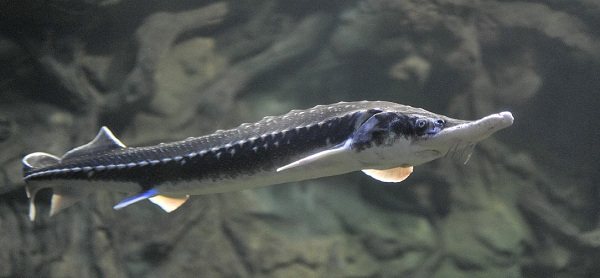
Beluga
The largest of the fish found in rivers, it reaches a length of 6 meters and weighs up to 2.5 thousand kilograms. Records are taken from the past. In the 21st century, belugas weighing more than 300 kilos are rarely caught.
Beluga is found in the Caspian and Black Seas, swimming into the Danube and the rivers of the Urals.
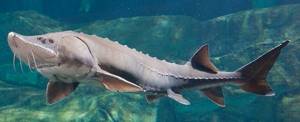
Russian and Siberian sturgeon
The Russian species lives in the Sea of Azov. The fish go to rivers to spawn. Until the flow of reservoirs was blocked, sturgeons swam unhindered to the upper reaches. Dams and hydroelectric power stations have made it difficult for fish to migrate, especially large ones.
Siberian sturgeon is a river fish. The fish do not go out into the open sea, feeding at the mouths of reservoirs. Individuals are smaller than Russians, growing up to 2 meters in length, gaining a 200-kilogram mass.
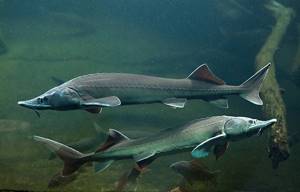
Thorn
It is a consequence of crossing beluga, sturgeon, and stellate sturgeon. Sea fish. Interspecific crossing, by the way, is typical for most sturgeons. This complicates the classification of relics.
The fish got its name because of the cone-shaped spines running along its back. The animal is also distinguished from other sturgeons by the antennae on its lower lip.
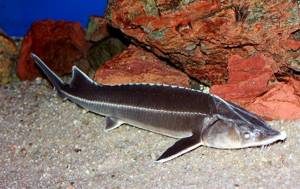
Salmonidae
Salmonids have an adipose fin near their tail. There is also a main dorsal process. Otherwise, salmonids vary greatly. Suffice it to say that among the representatives of the family there are both red and white fish.
Caspian and Baltic salmon
The Caspian species lives off the western shores of the Caspian Sea. Baltic fish live in the Black and Aral Seas.
Caspian salmon can weigh up to 51 kilograms, but often the mass of the fish is 10-13 kilograms. Baltic fish are slightly larger.

Salmon
On the White Sea coast it is simply called fish. When the north was being developed, the salmon population here was so large that only red fish were found. That's why the catch was called "fish". They didn’t know the other one. Salmon fed the settlers, allowing them to settle on harsh lands.
Scientists have found that salmon detects the smell of its native river at a distance of 800 kilometers. The fish spends the main part of its life in the sea. Salmon enter rivers to spawn.
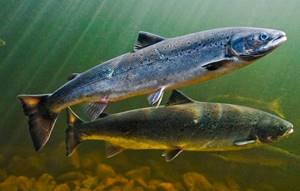
Chinook
The taste is similar to salmon, but less fatty. The red meat of Chinook salmon is especially prized in America. In Oregano and Alaska, the fish is even considered a national symbol.
Chinook salmon are also found in Russia. The fish is the largest among salmon. That’s why I sometimes call the animal king salmon.
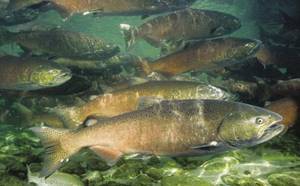
Chum salmon
Red fish, consisting of 5% fatty amino acids. Salmon meat is notable for its thiamine content. It blocks the harmful effects of alcohol. Therefore, nutritionists advise ordering dishes with chum salmon at parties.
Like pink salmon, chum salmon die after spawning. Fish leave the sea for rivers at 3-6 years of age. Accordingly, chum salmon live the same amount of time. Sometimes individuals are ready to reproduce only at 7-10 years of age.
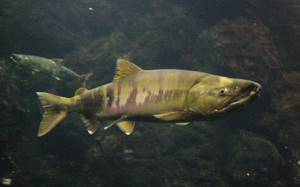
Pink salmon
Among salmon, pink salmon are the most stubborn and poorly oriented in space. Sometimes, instead of standard spawning sites, fish swim into unsuitable branches of rivers. If the entrance to their native reservoir is washed away, pink salmon literally jump onto the “fence.” There is no turning back or detours for humpback fish. This plays into the hands of miners who catch pink salmon during a period of turmoil.
When at sea, pink salmon are gray and almost not humpbacked. The body acquires a brownish-red tint and changes in rivers, that is, before spawning.
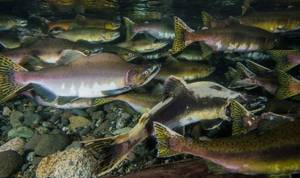
Red salmon
During the spawning period it turns bright red. In the sea, sockeye salmon, like other salmon, are silvery. Externally, the animal looks like a chum salmon. Inexperienced anglers confuse the species.
Sockeye salmon is a small fish. Representatives of the species grow to a maximum of 80 centimeters, gaining a 4-kilogram mass.
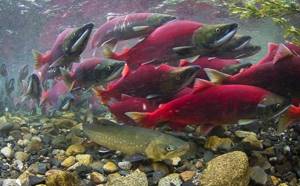
During spawning, sockeye salmon turns red
Coho salmon
It is not just gray, but has a distinct metallic cast. That's why coho salmon are nicknamed silver salmon. It grows to a meter in length, weighing about 15 kilograms.
Russians call coho salmon not silver, but white salmon. This is confusing to some. The fish has red meat.
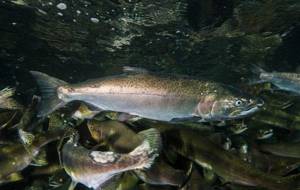
Coho salmon are also called silver salmon
Nelma
It is a symbol of the ichthyofauna of Siberia. The population lives off the coast of the Arctic Ocean. Nelma do not tolerate salt water with levels above 20 ppm. Therefore, fish concentrate at the mouths of rivers flowing into the ocean.
White salmon do not swim further west than the White Sea. The fish are red and large, reach one and a half meters in length, gaining 50 kilograms of mass.
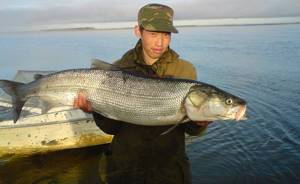
Whitefish
Opens the list of white meat salmon. Fish are variable, within the same body of water they can appear in 2-3 different forms. This makes species classification confusing.
Whitefish can be tall, short, elongated, but always toothless. This distinguishes representatives of the genus from other salmonids.
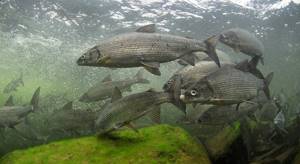
Omul
It is one of the main commercial fishes of Lake Baikal. There is also European omul. It is larger than the Baikal one. A 5-kilogram fish in the lake is nonsense, caught only once in the area of the Selenginsk settlement. Among European representatives of the genus, 4-5 kg individuals are more common.
Omul has tender, fatty, white meat. Non-saturated with healthy fatty acids and vitamins.
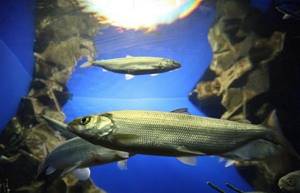
Trout
The genus includes 19 salmon subspecies. Some of them are marine, reaching a length of 100 centimeters. Other trout are river trout, stretching to a maximum of 50 centimeters.
All trout are voracious and active regardless of the weather. Fishermen fish even despite thunderstorms and winds. Trout use them to catch insects falling into the water. Some of them are torn off by the wind from coastal vegetation.

Smelt
Commercial salmon fish with white meat that smells like fresh cucumbers. For this reason, smelt was popularly called a cucumber. They catch it in cold waters, near the banks. The fish don't go far from them.
In Russia, smallmouth, Asian and European smelt are fished. These are commercial fish species , often caught by industrialists. Due to the small size of smelt, private owners prefer to catch larger inhabitants of the waters.
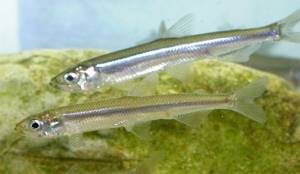
Carp
All cyprinids have high bodies and one dorsal fin. Most members of the family are hardy, surviving in oxygen-poor, freezing water bodies.
Carp
The fish is freshwater, but can swim into the brackish coastal areas of the Azov and Caspian Seas. Carp prefers areas overgrown with algae and grasses with a slow flow.
The body of the carp is covered with large and hard scales. There is a dark spot at the base of each plate. Another distinctive mark is two pairs of antennae on the upper lip of the animal.
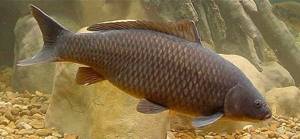
Carp
Fattening up like boars. The rate at which carp gain weight is really comparable to the growth of pigs, and the meat of the fish is fatty.
The name of the species comes from the Greek word "karpos", which means "fruit". The fish are indeed prolific. The female lays approximately 1.5 million eggs.
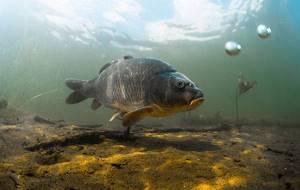
Bream
Sensitive to gear resistance. Suspecting something is wrong, the bream immediately throws the bait. But the carp is omnivorous. You can catch bream using croup, grass, or live bait.
Unlike most cyprinids, bream is sensitive to the oxygen saturation of water. When its percentage decreases in the summer heat, the fish float to the surface. There is a chance to catch large bream, which usually stay near the bottom.
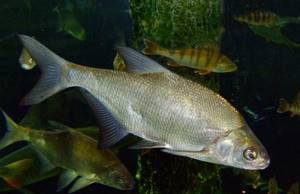
Asp
Among cyprinids, it is a pronounced predator, but individuals are dispersed throughout the reservoir, which complicates the industrial production of the species.
The asp reaches 90 centimeters in length, gaining a mass of about 7 kilograms.
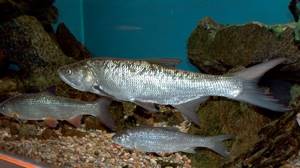
Roach
Bream is not particularly cautious; it can be caught using any tackle without choosing bait. Gluttony allows small fish to gain considerable weight. In some lakes of the Urals, 2-kilogram individuals are found. The standard weight of a roach is 400 grams.
Roach loves overgrown rivers and ponds with sluggish water. The abundance of vegetation makes catching difficult. Gear gets tangled in grass, snags, and algae.

Vobla
It is mined in the Caspian basin. The fins of the fish are red. When dried, vobla is considered a beer delicacy, which is why it is caught on an industrial scale.
In winter, the roach becomes covered with thick mucus. It protects the fish from the cold. Seeking warmth, cyprinids huddle close to the shores of reservoirs.
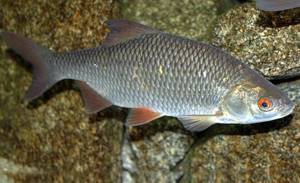
Herrings
The backs of herrings are always dark, and the bellies are silvery. Representatives of the family are laterally flattened and elongated. A single fin is visible on the back of the fish, and the tail has a pronounced notch.
Sprat
On the belly of the sprat there are scales that resemble thorns. These make up the keel of the fish. It makes the sprat invisible to predators looking at it from the depths. Additionally, the keel adds streamlining to the animal, improving maneuverability.
The average length of a sprat is 10 centimeters. The fish is prolific and widespread. In the 19th century, sprat was not eaten off the coast of England, but was sent to fertilize fields, so there was a massive catch.
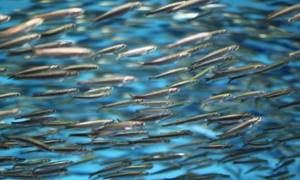
Sardines
For the first time, mass catching of the species began off the island of Sardinia. Hence the name of the fish. It reaches a maximum length of 25 centimeters.
The sardine differs from other herrings in having wing-shaped scales at the ends of the caudal fin and protruding rays of the anal outgrowth.
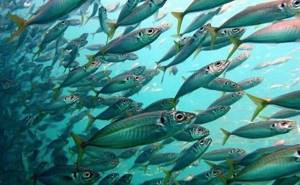
Tulka
This is a miniature herring. Some species live in fresh waters. Thus, the Abrau sprat lives in Lake Abrau, in the Krasnodar Territory. The reservoir is mountainous and cold.
Common species of sprat live in the Caspian, Azov and Black Seas.

Atlantic, Pacific, Baltic and Azov-Black Sea herring
Herring is recognized as the most numerous fish in the world. Representatives of the species prefer cold waters. The northern commercial fish reaches a length of 40 centimeters.
Historically, herring tend to migrate. Until the 15th century, for example, animals filled the Baltic and North Seas. In the 16th century, the shoals moved into Scottish waters. Perhaps the fish called Caspian, Azov and Black Sea fish today will change their names in a couple of centuries.
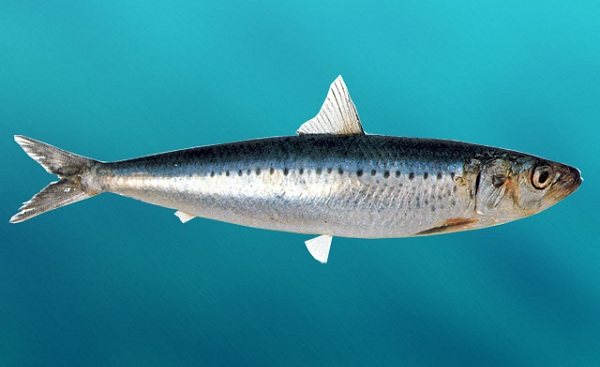
cod
The pectoral fins of fish are located next to or in front of the ventral fins. There are 2 anal processes, and 3 dorsal ones. The exception is the burbot. It has 1 anal fin and only 2 dorsal fins.
Haddock
Lives in the Arctic Ocean basin. Approximately 0.5 million tons of cod fish are harvested from its waters annually. Some individuals reach 75 centimeters in length, weighing about 4 kilograms.
The dark back of the haddock has a lilac tint. The abdomen of an animal is milky in color. There are dark spots on the sides of the head.
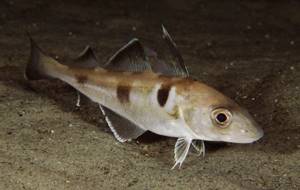
Navaga
It stands out among cod because it has a rich composition, is most beneficial for health, but only fresh. When defrosted, navaga loses valuable microelements and vitamins.
The average length of navaga is 40 centimeters. Externally and in importance it is similar to pollock.
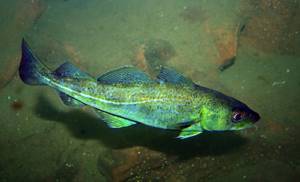
Burbot
The only cod fish that lives in fresh waters. They should be cold. Heat is detrimental to burbot. It is caught in the basins of the Black, Caspian, Baltic and White seas.
Among the rivers of Siberia, burbot have chosen the Yenisei and Selenga.
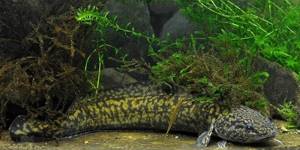
Cod
Lives in cold waters. Cod is caught not only for meat, but also for the tongues and cheeks of the fish. They are considered a delicacy.
Cod is often mentioned when the names of game fish . The meat of the inhabitants of cool waters is often dried. This causes the fibers to crack. Hence the name of the animal.
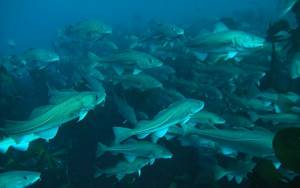
Scombridae
Black Sea mackerel
It has a brindle coloration, a laterally compressed, elongated body. The back of the animal is green. Mackerel meat is rich in fatty amino acids. The average length of Black Sea individuals is 50 centimeters.
With a length of half a meter, mackerel weighs about 400 grams. Individuals gather in schools of thousands, making it easier for fishermen to catch.
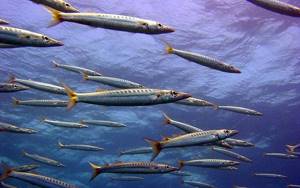
Atlantic mackerel
Fatter and larger than the Black Sea one. Representatives of the northern species stretch 60 centimeters, gaining a mass of 1.6 kilograms.
Mackerel flock in schools based on size. Fishes of the same size swim together. Having caught one small individual, there is a high probability of catching dozens more of the same kind. If you catch a large mackerel, the next fish will probably be trophy ones.
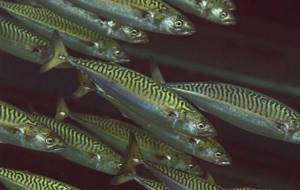
Formosa, 30 mm
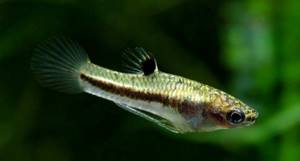
Formosa is one of the smallest fish in the world, measuring barely three centimeters. The Formosa lives in the fresh, calm waters of South America.
This fish lives for about three years and will be a wonderful decoration for a home aquarium. In the wild, the Formosa lives in a pack and loves to hide. Fish feed on midges, worms and larvae, and can also eat algae.
Predators of the sea
Among ocean fish, sharks are far from the only predators. There are many other aggressive representatives.
Moray eel likes to hide. To do this, she uses caves, coral reefs and thickets of vegetation. The body is quite elongated; with a length of three meters, its thickness is only 30 centimeters. It has a strong jaw, which it actively uses when hunting. Easily camouflaged and attacks from ambush, holds prey tightly with its mouth, uses its tail to hold or tear the victim. With poor eyesight, he has an excellent sense of smell.
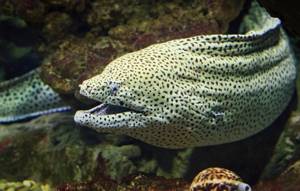
One of the dangerous sea predators is the moray eel, which tears its prey with its long tail.
Barracudas are somewhat similar to giant three-meter pikes. They are dangerous to human health and can bite off limbs and cause other injuries. They attack suddenly and indiscriminately, including eating poisonous food. Because of this, their meat is toxic and is not used in gastronomy.
The swordfish is larger in size than many sharks - three meters long and almost half a ton of mass. The most dangerous part of the body is the long bone growth on the upper jaw.
Because of its resemblance to a sword, the fish got its name. Thanks to the four-ton impact force, the swordtail is capable of breaking through an oak board half a meter thick. The predator has no scales.
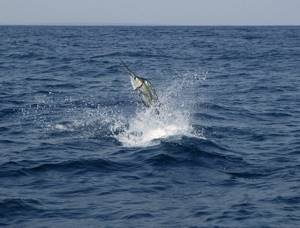
The European fishing rod is also called the devil. This is due to its extremely unattractive appearance. Its wide mouth is shaped like a crescent moon, its lower jaw is extended, and its eyes are located close to the middle of its head. On the long fin above the upper jaw, bacteria actively multiply and attract fish. If the bait does not work, the anglerfish can rise up and swallow whole a bird that has landed on the surface of the water.
Tuna is a predator that prefers to gather in schools. Its four-meter body can weigh half a ton, but the fish can swim at a speed of 90 kilometers per hour. Tuna is actively used in gastronomy; the French even call it sea veal.
Pelamida also has a silver color, but is much smaller in size. It is no longer than 85 centimeters and weighs no more than 7 kilograms. There are faint stripes on the back that have a blue tint. The fish gather in schools and hunt for sardines and anchovies.
Sinarapan, 30 mm
Sinarapan 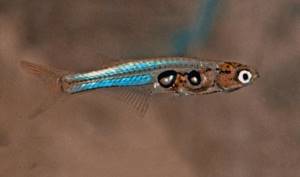
The population of this small fish is on the verge of destruction due to active fishing for this species. Despite its small size, the fish is considered a delicacy. This baby lives in freshwater and loves depth. The fish has become popular due to its pleasant taste, which is revealed with a vegetable side dish and when properly cooked. This fish is fried or boiled.
Micro-assembly, 20 mm
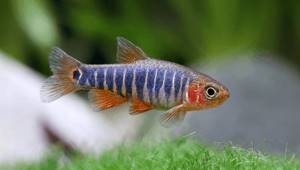
Microrasbora is a very small fish, the size of which does not exceed 20 millimeters. This baby lives in the tropics of Asia and leads a gregarious lifestyle.
This is a very energetic fish that will be a wonderful addition to the aquarium. Microrasbora prefers only fresh water and loves to hide behind various kinds of shelters, from pebbles and shells to dense thickets of algae.
Caspian goby, 20 mm

Caspian goby , as the name suggests, lives in the waters of the Caspian basin. In addition, this species can be found in large numbers in the Volga.
The Caspian goby loves shallow waters and feels most comfortable near the shore. It feeds mainly on small crustaceans and tiny plankton.
This fish generally leads a very passive lifestyle and sticks to the bottom. Larger predators like to feed on this fish. It is not currently a fishery object.
Mystichthys, 12.5 mm

An amazing fish called mistichthys is unique in that it is absolutely transparent. Their habitat is the Philippine Islands; in addition, they also live in the waters of sea lagoons and among the waters of mangroves.
A distinctive feature of these fish is that they swim far into the open ocean to spawn. Moreover, despite their small size, they are an integral part of the Philippine fisheries.
Pandaka dwarf goby, 11 mm
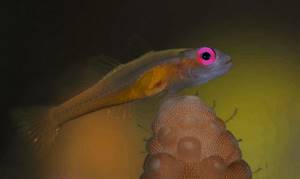
For aquarists, this baby became known back in 1958, despite this, keeping it in captivity is a very difficult task. This schooling fish, despite its size, is a fishery for local residents. They make it into a snack and eat it regularly.
Due to its small, almost imperceptible size, the study of this species is problematic. They hide almost their entire lives on the seabed, under the protection of shells and various other natural shelters.
Dwarf goby, 9 mm

The dwarf goby is one of the smallest fish in the world, whose body length does not exceed nine millimeters. This baby comes from distant Australia and Asia, or rather its southeastern part, in addition, it is also found in the Philippines.
In its homeland, the fish, despite its small size, is actively consumed as food. The weight of a dwarf goby is only four grams.
Mackerel
This is another old friend.
- In terms of useful substances, mackerel is almost no different from herring, and besides, it contains large doses of fluoride, which is responsible for dental health.
Of course, you shouldn’t eat smoked mackerel often - this product will do nothing but harm, but baked in the oven or on the grill is practically a delicacy!
By the way, an interesting fact:
- Mackerel is one of the most widely fished fish species in the world. There are only pollock, tuna and herring from the Atlantic ahead. And in the very first place is the Peruvian anchovy
1. Paedocypris progenetica, 8 mm

This fish is the smallest fish in the world and it lives exclusively off the coast of Indonesia. The size of this little one is only about eight millimeters, and it belongs to the family of carp fish.
For the first time, this small fish was discovered not in the ocean, or even in the sea or river, but in a swamp. Moreover, the water in this reservoir had a high level of acidity. Paedocypris progenetica has chosen for itself the bottom areas of the reservoir, where cold, flowing waters predominate.
They also avoid open, well-lit spaces and prefer to hide in the shadows. It is possible that this is why their body is almost transparent.
9 0
Idiokant - glowing monster
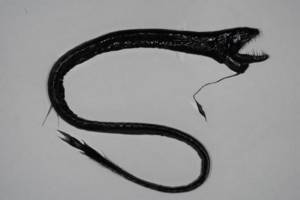
The fish of the oceans in their diversity have not only beautiful creatures, but also truly monstrous ones. This is exactly what an idiot is. This creature resembles a worm with a huge mouth, which has long and sharp teeth. It is found in the temperate waters of the Atlantic, Indian and Pacific oceans, living at a depth of five hundred to two thousand meters.
Females are brown and black and grow up to fifty centimeters. Males are much smaller (only seven centimeters) and their color is light brown. These fish have no scales. Interestingly, not only the bodies of these fish glow, but also their teeth. A long, luminous process hangs from the lower jaw, which serves as bait for fish lost in the dark, deep waters.
During the daytime, these fish are at depth, and at night they rise to the surface to dine. Females are especially voracious. They can swallow quite large prey, and their entire body is adapted to such a diet: the jaws open like a snake, thanks to the non-ossified first vertebra, the stomach can stretch to incredible sizes. When swallowing large food, all organs are removed so as not to be subject to possible damage.
